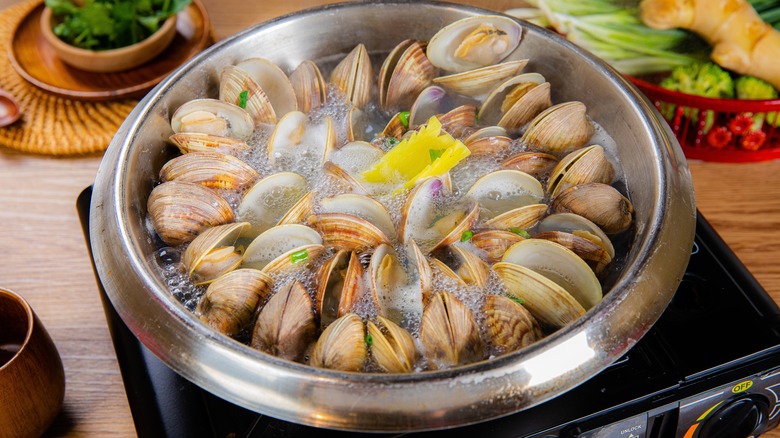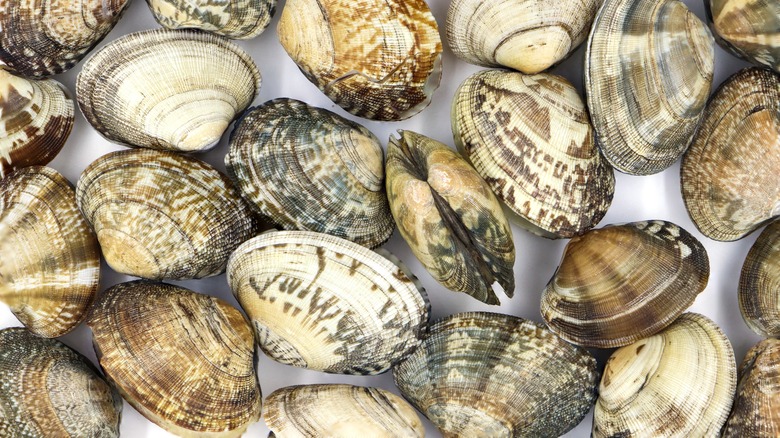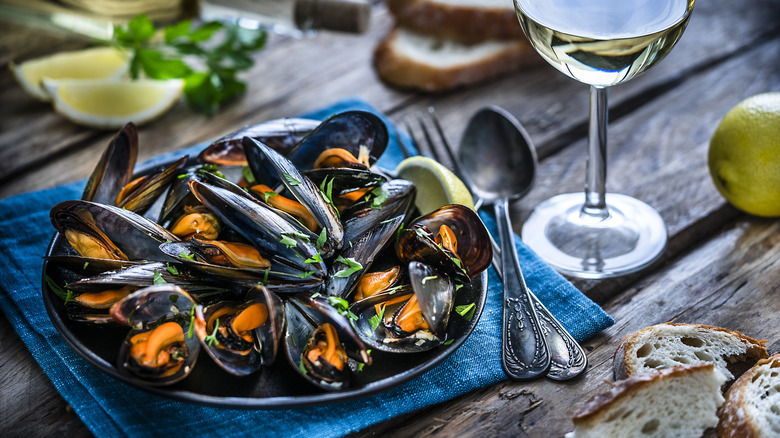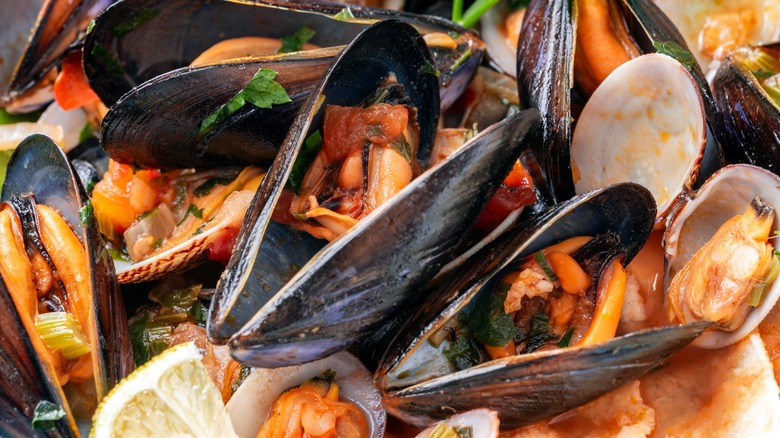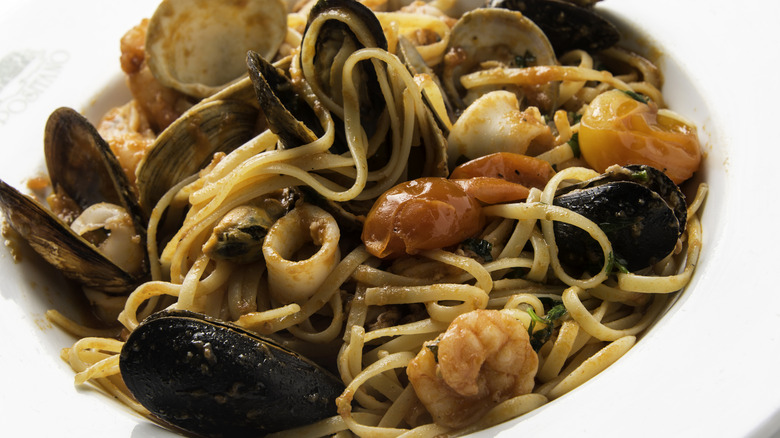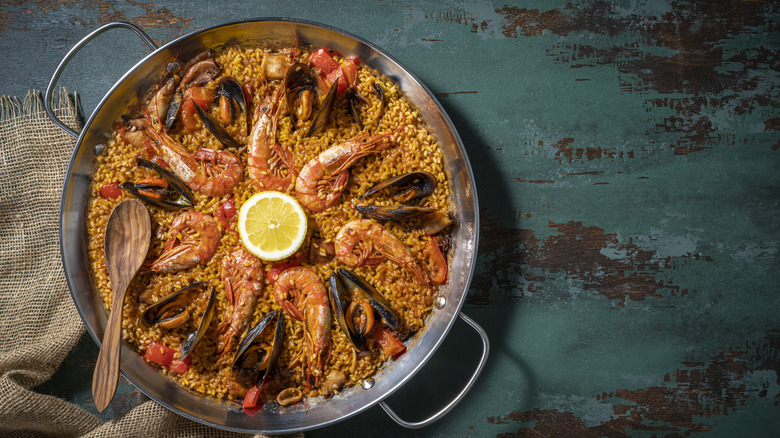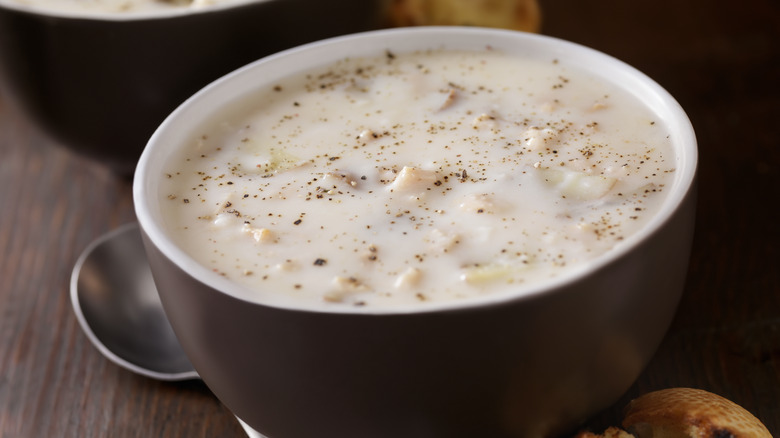The Exact Difference Between Clams And Mussels
Clams and mussels have a storied history. Ancient Romans and Native Americans both ate mussels, and Native Americans even smoked and dried them as a preservation technique. Likewise, people have eaten clams for thousands of years, with early Canadians setting up clam gardens that helped them grow faster. To an untrained eye or to someone who doesn't eat seafood very often, clams and mussels can appear very similar, especially once they've been removed from their shells.
Clams and mussels both belong to a group of animals called mollusks, which are soft-bodied invertebrates that are usually encased in a shell. They are also both filter feeders, which means they filter water to extract tiny particles of food to eat. The water passes through fringes on their shells, and this is how they filter their food and nutrients. While they look alike and even have a similar taste, there are many differences between clams and mussels that make them delicious and unique parts of various dishes.
Types of clams
If you've only ever seen small sand-colored hard clams, you're probably missing out on quite a few of the many different clam varieties. There are actually a lot of different types of clams; some of the varieties include hard clams, soft clams, manila clams, and razor clams.
Hard shell clams can be called many different names, including quahog, littleneck, topneck, cherrystone, and chowder clams. The different names of hard clams simply refer to the size, rather than the type of clam. Bigger hard shell clams tend to be more chewy. Soft clams are sometimes also called steamer clams and are typically on the sweeter side. Manila clams can be described as sweet, plump, and tender, and they're a versatile variety that works well in many different dishes. Razor clams aren't shaped like a traditional clam; instead, they have a long, thin shell. They're a soft and delicate clam that is often eaten steamed.
Types of mussels
Of the many different types of mussels, there are about 17 that are edible. Some of the common types that are typically eaten include blue mussels, Pacific blue mussels, New Zealand green-lipped mussels, and Mediterranean mussels.
Blue mussels are smaller in size than many other types, but they're very popular, and they have a sweet flavor with a tender texture. They're also considered a sustainable seafood choice by The National Marine Fisheries Service (NOAA Fisheries). Mediterranean mussels are very meaty, and they're sweet with a full-bodied flavor. Pacific blue mussels are mild and sweet, and they have a fresh ocean flavor. They typically come from the cooler waters of the North Pacific, such as Alaska and the Pacific Northwest. New Zealand green-lipped mussels unsurprisingly come from New Zealand. They're rather large and firm, and they have a light taste. Many people also like them for their high nutrient content.
How to tell the difference between clams and mussels
For many people, it might be difficult to tell the difference between clams and mussels because they're in similar types of shells, and the flesh inside can look similar as well. Both mollusks have two shells that can vary in appearance, but clam shells are typically more rounded and pretty symmetrical, while mussels are usually longer. As far as color, clam shells are often gray or light brown and white, whereas mussels are usually darker: Dark blue, dark green, or black.
If you're trying to tell the difference based on taste, you'll notice that clams are often more chewy than mussels. They're also more sweet and salty. Mussels, on the other hand, tend to have a more robust flavor that can be described as nutty, and they're typically a bit more tender than clams. Of course, the type of clam or mussel you eat is definitely going to have an impact on the overall flavor and texture.
What do clams and mussels taste like?
Before diving into the taste, it can be helpful to understand the habitat of clams and mussels. They both live in similar habitats and are able to survive in saltwater and freshwater, though you're more likely to find clams in saltwater. Typically, clams are found in sediment in bays, seas, and oceans. Mussels, on the other hand, are usually in clusters on rocks or in the seabed, and they can also attach to manmade surfaces. Mussels tend to stay put on their hard surfaces, while clams move around.
The habitat of the mollusk can play a role in how it tastes, but you will find differences between the two that are pretty consistent regardless of where they came from. In general, clams have a sweeter and saltier taste than mussels as well as a firmer texture. The flavor of a clam is a bit more in your face when compared to a mussel. Mussels, on the other hand, are also sweet but tend to have a more robust flavor profile and aren't quite as strong or salty. People sometimes describe them as tasting earthy or nutty. They tend to be a bit more tender, and they can even become creamy when used in certain recipes.
How to eat clams and mussels
Before you eat a mollusk, it's important to take care in cleaning it. The process is pretty similar for both clams and mussels. First, remove any mollusks with broken or cracked shells, as well as any open clam shells. If you find an open mussel, try tapping on the shell; if it shuts, it's good to use. Then, let mussels soak in water for around 20 minutes, and let clams soak for 20 minutes to 1 hour (add ⅓ cup of sea salt per gallon of water for clams). When you remove them from the water, lift them out so that you leave any sand or sediment at the bottom of the bowl. For mussels, you'll need to debeard them by pulling the threads near the hinge end until they snap off, then soak them in a new bowl of water. Finally, scrub the shells with a stiff bristle brush and rinse.
In terms of recipes, clams are often used in clam chowder, pasta dishes, or steamed with butter. Mussels are commonly used in paella or cooked in a creamy wine or garlic sauce. While it's not typically recommended to substitute one for the other in a recipe, they can be used together in the same recipe. Try them together in hearty cioppino soup. Regardless of the recipe you're putting your mollusks in, you'll know they're done cooking when the shells open up. Take care not to overcook them, as that can cause them to become rubbery and chewy.
Can you substitute clams for mussels and vice versa?
If you're whipping up a delicious clam chowder or moules frites, you may be wondering if it's acceptable to substitute clams or mussels for each other, especially if you suddenly realize you only have one or the other available to you. Swapping one out for the other isn't the best situation, but you can make it work if you need to.
When you have to do what you have to do, you just have to make the best of your situation. Because clams tend to be more salty than mussels, you'll probably want to increase the salt in the recipe if you're swapping in mussels and vice versa. Of course, you'll want to make sure you're cooking your clams and mussels safely, so if you make a swap in a recipe, you might need to adjust the cooking time or technique accordingly. For example, a large chowder clam will probably take closer to 10 minutes to cook while a smaller blue mussel might take closer to 5 minutes. And if you're making something like a seafood gumbo, feel free to pick clams, mussels, or both, whichever you prefer.
